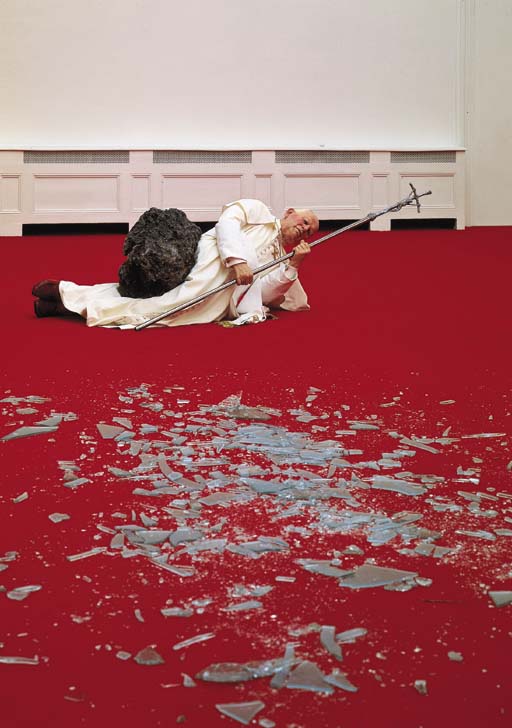
Maurizio Cattelan’s installation of La Nona Ora (The Ninth Hour) is a life-sized effigy of Pope John Paul II struck down by a meteor. First exhibited in 1999 at the Kunsthalle Basel, La Nona Ora was featured at the Royal Academy in London in 2000, and also at the Zacheta Gallery of Contemporary Art in Warsaw. Christie’s sold the piece in 2001 for $886,000, and a second version was auctioned by Phillips, de Pury & Company in 2004 for $3 million.
Much of the controversy that results from La Nona Ora is immediate and overt. The realistic figure of Pope John Paul II, in characteristic vestments and still clutching the Papal Cross, lies on the ground after having been crushed by a meteor. The original installation was under a shattered skylight, with the Pope beneath the meteor on a vast red carpet with shards from the skylight. The scene is quite sensational and results in a range of narrative interpretations.
The title of the work is traditionally significant in the Liturgy of the Hours of the Catholic Church, and among other things, suggests mourning and the supposed hour of Christ’s death. Beyond this, all sorts of narratives may result. Perhaps Cattelan, a Roman Catholic, suggests the calamitous degradation of the Church as a result of scandals and quickly changing social values; or perhaps he celebrates it with this extraterrestrial injury to the Pope. Because the meteor has apparently fallen from the sky – literally from the heavens – it may interpreted be that God himself has assaulted the Church. As the Pope survives and clings to the Papal Cross, perhaps he represents the Church’s eternal fortitude. Oppositely, we may conclude that he is only a man and should not be venerated.
What must be considered about each of the preceding interpretations is that they would have been unacceptable even decades earlier. Moreover, Cattelan’s installation would have never been envisioned earlier than the twentieth century and such discourse would have been really impossible.
Certainly the most notable controversy caused by this work occurred in Warsaw at the Zacheta Gallery when two members of Poland’s Parliament, Halina Nowina-Konopka and Witold Tomczak, removed the rock from atop the wax Pope and attempted to stand the figure upright. The two also led a petition with ninety members of Parliament demanding the dismissal of the gallery’s director, Anda Rottenberg. After La Nona Ora had already been seen in Basel and in London it caused quite a disturbance in Warsaw, revealing the significance of site-specificity in a Catholic-dominant country that was also the homeland of Pope John Paul II.
Notwithstanding that the president of Poland, Aleksander Kwasniewski, and two local priests had defended the installation, the Parliament and Catholic-majority Poland were intolerant of the installation. Tomczak suggested that Rottenberg, a Jew, should move to Israel and commission an installation of a rabbi being crushed by Yasser Arafat. As the controversy continued, she received piles of anti-Semitic hate mail and resigned from the gallery several months later. Any interpretation of the situation was divisive, resulting in Rottenberg identified as either an insensitive Catholic-basher or a victim of anti-Semitism.
President Kwasniewski and the priests had described the installation as an allegory for the Pope’s heavenly burden and Rottenberg called it “an egalitarian monument.” In an interview with Alicia Bona from Christie’s, Cattelan reflected that “what happened in Poland was a sort of upside down miracle: salvation wasn’t coming from the sky but from the earth, from the people” to save the Pope.
After the controversy seemed to have lessened in 2001, Cattelan avoided very specific interpretation of the work and modestly advised that “La Nona Ora could simply be a bad joke taken too seriously, an exercise in absurdity […] In the end it is only a piece of wax.”